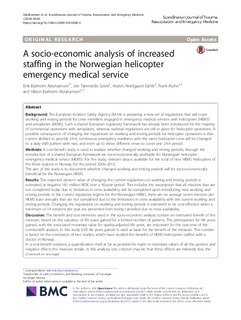| dc.contributor.author | Abrahamsen, Eirik Bjorheim | |
| dc.contributor.author | Selvik, Jon Tømmerås | |
| dc.contributor.author | Dahle, Anders Nordgaard | |
| dc.contributor.author | Asche, Frank | |
| dc.contributor.author | Abrahamsen, Håkon Bjorheim | |
| dc.coverage.spatial | Norway | nb_NO |
| dc.date.accessioned | 2018-11-21T14:52:57Z | |
| dc.date.available | 2018-11-21T14:52:57Z | |
| dc.date.created | 2018-10-29T20:24:17Z | |
| dc.date.issued | 2018-11 | |
| dc.identifier.citation | Abrahamsen, E.B. et al. (2018) A socio-economic analysis of increased staffing in the Norwegian helicopter emergency medical service. Scandinavian Journal of Trauma, Resuscitation and Emergency Medicine. 26(83), pp. 1-9. | nb_NO |
| dc.identifier.issn | 1757-7241 | |
| dc.identifier.uri | http://hdl.handle.net/11250/2574184 | |
| dc.description.abstract | Background: The European Aviation Safety Agency (EASA) is preparing a new set of regulations that will cover working and resting periods for crew members engaged in emergency medical services with helicopters (HEMS) and aeroplanes (AEMS). Such a shared European regulatory framework has already been introduced for the majority of commercial operations with aeroplanes, whereas national regulations are still in place for helicopter operations. A possible consequence of changing the regulations on working and resting periods for helicopter operations is that current abilities to provide 24-h, continuous emergency readiness with the same helicopter crew will be changed to a daily shift pattern with two, and even up to three, different crews to cover one 24-h period.
Methods: A cost-benefit study is used to analyse whether changed working and resting periods, through the introduction of a shared European framework are socio-economically profitable for Norwegian helicopter emergency medical service (HEMS). For the study, relevant data is available for the total of nine HEMS helicopters of the three regions in Norway, for the period 2006–2013. The aim of the study is to document whether changed working and resting periods will be socio-economically beneficial for the Norwegian HEMS.
Results: The expected present value of changing the current regulations on working and resting periods is estimated at negative 181 million NOK over a 40-year period. This includes the assumption that all missions that are not completed today due to limitation in crew availability will be completed upon introducing new working and resting periods. In the current regulatory regime for the Norwegian HEMS, there are on average seven missions per HEMS base annually that are not completed due to the limitations in crew availability with the current working and resting periods. Changing the regulations on working and resting periods is estimated to be cost-effective when a minimum of 14 missions per year are prevented from being cancelled due to crew availability.
Discussion: The benefit and cost elements used in the socio-economic analysis contain an estimated benefit of the measure, based on the valuation of life years gained for a limited number of patients. The prerequisites for life years gained, with the associated monetary value for quality-adjusted life years, are important for the outcome of the cost-benefit analysis. In this study 6.95 life years gained is used as basis for the benefit of the measure. This number is based on the conclusion of two studies, which have studied the benefits of HEMS helicopters staffed with a doctor in Norway. In a cost-benefit analyses, a quantification shall as far as possible be made in monetary values of all the positive and negative effects the measure entails. In this analysis, one criticism may be that these effects are relatively few, theinvestment costs (the increased operating costs) are not provided a detailed description of, and other factors such as; effect on the environment, risk of simultaneous requirements of the HEMS helicopter with possible negative effect for the patient who most needs it, likelihood of accidents with associated negative effect are neither included in the cost-benefit analysis.
Conclusion: Alternations to the working and resting periods for Norwegian HEMS operations that will result in a change from the current 24-h, continuous emergency readiness with the same crew, to a set-up with two, and up to three, different crews are not found to be socio-economically beneficial. | nb_NO |
| dc.language.iso | eng | nb_NO |
| dc.rights | Navngivelse 4.0 Internasjonal | * |
| dc.rights.uri | http://creativecommons.org/licenses/by/4.0/deed.no | * |
| dc.subject | akuttmedisin | nb_NO |
| dc.subject | luftambulanse | nb_NO |
| dc.subject | helicopter emergency medical services | nb_NO |
| dc.subject | hems | nb_NO |
| dc.subject | socio-economic analysis | nb_NO |
| dc.title | A socio-economic analysis of increased staffing in the Norwegian helicopter emergency medical service | nb_NO |
| dc.type | Journal article | nb_NO |
| dc.type | Peer reviewed | nb_NO |
| dc.description.version | publishedVersion | nb_NO |
| dc.rights.holder | © The Author(s). 2018 | nb_NO |
| dc.subject.nsi | VDP::Medisinske Fag: 700::Klinisk medisinske fag: 750::Traumatologi: 783 | nb_NO |
| dc.source.pagenumber | 1-9 | nb_NO |
| dc.source.volume | 26 | nb_NO |
| dc.source.journal | Scandinavian Journal of Trauma, Resuscitation and Emergency Medicine | nb_NO |
| dc.source.issue | 83 | nb_NO |
| dc.identifier.doi | 10.1186/s13049-018-0548-4 | |
| dc.identifier.cristin | 1624675 | |
| cristin.unitcode | 217,8,3,0 | |
| cristin.unitname | Institutt for sikkerhet, økonomi og planlegging | |
| cristin.ispublished | true | |
| cristin.fulltext | original | |
| cristin.qualitycode | 1 | |

